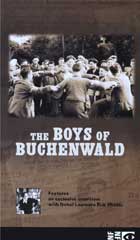
Boys of Buchenwald 2002
Distributed by National Film Board of Canada, 1123 Broadway, Suite 307, New York, NY 10010;800-267-7710
Produced by David Paperny
Directed by Audrey Mehler
VHS, color and b&, 46 min.
Jr. High - Adult
Holocaust and Genocide Studies, Museums, History
Date Entered: 12/30/2003
Reviewed by Karen Plummer, Cataloging Department, Bierce Library, University of Akron, Akron, OHThese films are somewhat unusual in terms of Holocaust documentaries. Both films focus on the aftermath of the Holocaust; what happened to some of the survivors (Boys of Buchenwald) and how we educate future generations and preserve the physical reality of the sites of the genocide (Holocaust Experience).
The Holocaust Experience examines two types of educational experiences: museums in the United States (the Simon Wiesenthal Center Beit Hashoah Museum of Tolerance in Los Angeles and The United States Holocaust Memorial Museum in Washington, DC) and a concentration camp site (Auschwitz-Birkenau, now designated a state museum in Poland).
Using photographs, film, artifacts from the camps, and survivor lectures as educational tools, the Simon Wiesenthal Center Beit Hashoah Museum of Tolerance and the US Holocaust Memorial Museum reinforces their lessons by having visitors focus on a single person. Entering the museum, the visitors take a card or passport-type of document that includes a picture of a person, information about their life, and whether or not they survived. It is overwhelming to try to conceive of the great number of people who went through the so this process of focusing on a single person’s fate helps to make it more personal to the visitor.
In stark contrast to the ordered reenactments of the camps in the museums, we are taken to Auschwitz-Birkenau. The camp is fighting against time, natural forces, and a growing surrounding community to survive. Many buildings were destroyed just after the war and many of those that remain are deteriorating. As laborers work to restore concrete poles, the curator of the museum attempts to widen the “protected” zone to enclose all portions of the camp.
There is something so moving about the scenes at the camp. As visitors make their way past the gates emblazoned with the words “Arbeit Macht Frei” (Work Brings Freedom), they are walking on the same ground as those killed so many years ago. In one field, you can still pick up bone fragments from the mass graves. You can stand near the railroad siding where the selections took place. Visitors become very silent. Many visitors remark that the level of emotional impact is so much greater at Auschwitz-Birkenau than when visiting the other museums. Many comment on their need to personally view the camp, while others say they cannot face the reality of all the deaths.
The second film, The Boys of Buchenwald, provides a rare view of a very special group of survivors. With their liberation from Buchenwald concentration camp, 460 young boys were sent to France as displaced persons. The boys had a difficult time ahead of them. They had to realize that their families were gone and they could not go home again. They had to learn how to live again; how to trust people; how to hope; how to cry. Their caregivers felt that they might be “damaged beyond repair” or psychopathic. The boys had suffered so much hunger and despair that they would hoard food and the rage they felt about their experiences exploded in fights and episodes of setting fire to mattresses.
As the boys adapted to life outside the camp, they were broken down into smaller groups and sent to other homes in France. Here they began going to school and interacting with their caregivers more as a family. In some cases interacting with local families only brought back memories of all those people that they had lost, so the relationship they built with the other boys became more and more important. The boys were naturally drawn to each other and formed long-lasting friendships, particularly with those boys who were from the same area as they were from originally.
When it became time for the boys to move on with their lives, they generally sought out places far from their homeland, places such as Australia, Canada, and the United States where they felt they would be far enough away from any new Holocaust and they would be safe. Most of the boys lived with Jewish foster families and began living life to the fullest.
Interspersed with photographs and film clips of those years, Robbie Waisman, Joe Szwarcberg, Nobel Peace Prize winner Elie Wiesel, and other individuals within this group share their feelings and experiences. Almost 60 years after their liberation, a group of these survivors revisit France, touring the homes they had lived in and sharing their memories. We also see them attending a reunion in Jerusalem.
Of these two films, The Boys from Buchenwald is an essential addition to any comprehensive Holocaust collection and is highly recommended. While showing the horrors of the concentration camp, it also shows the amazing strength of the human spirit and profiles survivors in a way that few documentaries have done in the past. The Holocaust Experience is a more marginal purchase (recommended) and would be a particularly useful addition to a museum sciences collection. These films would be appropriate for junior high school students through adults. It should be noted that both films contain very graphic images of camp inmates and victims of the gas chambers.